If you’re running a theater or managing airport operations, you know that every long line is lost revenue. Every delayed check-in adds pressure and disturbs your workflow. That’s why more theaters and airports are turning to self-service kiosks. They move customers faster, cut labor costs, reduce errors, and free up staff.
Your customers hate slow check-ins, and businesses that still rely on full-service counters are falling behind. This guide shows what modern kiosks do, how customers interact with them, and how they help operators run faster operations.
What Is a Cinema Kiosk and How Does It Work?
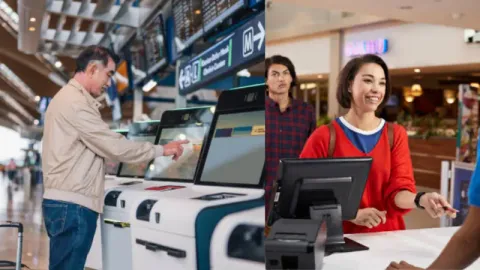
Cinema kiosks are self-service machines that let customers handle tasks like buying tickets, selecting seats, and ordering snacks. There is no need for staff involvement.
They are typically touchscreen-based and connected to the theater’s point-of-sale system. Cinema kiosks speed up service and offer a more streamlined experience for both customers and operators.
Key Hardware and Software Components of a Cinema Self-Service Kiosk
Cinema kiosks need reliable hardware and tightly integrated software to function smoothly. This setup ensures a seamless user experience and enables real-time syncing with ticketing, concessions, and loyalty systems.
Key Hardware Components
The hardware is designed for high-traffic environments and must support fast, reliable transactions.
- Large touch screen: The operation is sensitive, and users can easily choose movies, seats, and order snacks. The interface is clear and easy to use.
- Thermal Printer: Prints tickets and receipts instantly. Often built into the kiosk enclosure.
- QR/Barcode Scanner: Scans loyalty cards, coupons, or mobile tickets for faster check-in.
- Card Reader and NFC Module: Accepts chip cards, contactless payments, and digital wallets like Apple Pay or Google Pay.
- Cash Acceptor (optional): Some kiosks still include cash modules to serve cash-only customers.
Key Software Components
The software connects the kiosk to internal systems and handles real-time transactions.
- POS Integration: Syncs ticketing and concession data with the main sales system.
- Loyalty and Rewards Module: Allows customers to earn or redeem points and use promo codes.
- Seat Mapping and Availability API: Displays live seating options and updates them instantly after purchase.
- User Interface Layer: Simple, step-by-step UI for selecting shows, seats, and checkout. Supports multiple languages.
Typical Use Cases in Theaters
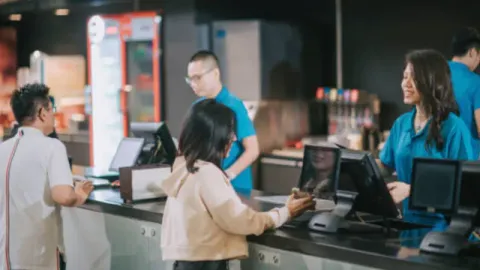
Most theaters install kiosks to reduce manual workload and improve customer service. Here’s how they’re used in real-world settings:
- Ticket Purchase
Customers walk up, choose a movie, select showtime and seats, and pay directly—no need to queue at the counter.
- Food and Beverage Pre-Orders
Some kiosks offer menu browsing and ordering. Customers place their order before the show starts and pick it up at the counter.
- Mobile or QR Code Pickup
Guests who booked online can scan their confirmation code at the kiosk to print their tickets.
- Loyalty Program Redemptions
Kiosks let users log in or scan their loyalty cards to redeem points or apply offers during checkout.
Airport Self-Service Kiosks (Similar Tech As Cinema Kiosks But Different Workflow)
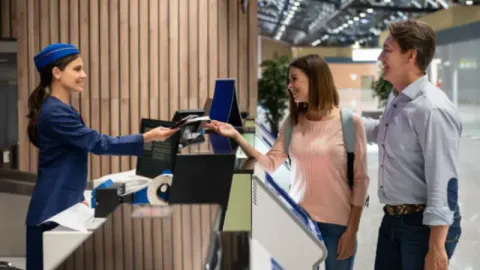
Airport kiosks work like cinema kiosks in using self-service, but their goals are different.
In cinemas, it’s all about creating a great experience and encouraging extra purchases.
In airports, it’s about speed—checking IDs, printing boarding passes, and handling luggage quickly.
These kiosks are built to manage stressful, fast-moving situations with lots of people.
What Airport Kiosks Do
Modern airport kiosks streamline many parts of the check-in process. They’re especially useful for domestic flights.
Here’s what they typically handle:
- Passenger Check-In: Travelers enter a confirmation number, scan their passport, or swipe a credit card. This lets them access their reservation.
- Boarding Pass Printing: Once check-in is confirmed, the kiosk prints a boarding pass…sometimes with a baggage tag if needed.
- Seat Selection and Upgrades: Passengers can select or change their seat or pay for a premium upgrade.
- Document and Data Sync: Kiosks often scan passports or ID cards and sync data with airline systems in real-time.
- Baggage Tagging: Some kiosks also print bag tags for self-drop luggage counters, speeding up baggage handling.
How Passengers Actually Use Airport Kiosks
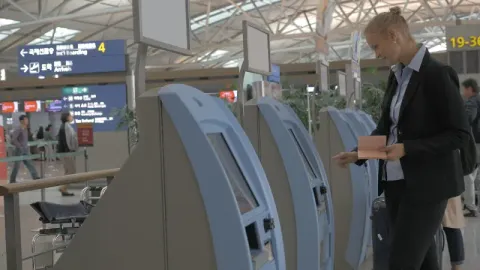
For most travelers, using a kiosk starts the moment they walk through the terminal doors:
- They walk up, tap the screen, and select a language.
- They enter their booking reference, scan their passport, or swipe a card.
- Once their flight details load, they check their seat, make changes if needed, and confirm. The kiosk prints a boarding pass. If they’re checking a bag, it also prints a luggage tag.
- From there, they head to the bag drop or straight to security.
The entire process usually takes under two minutes, far quicker than waiting in line at the counter.
Kiosk UX in Busy Airport Settings
Airports deal with large, diverse crowds under time constraints. That makes UX design critical.
- Speed-First Interface: Airports prioritize quick tap-and-go actions with minimal screens.
- Multilingual Support: Kiosks offer 5–10 languages to assist international passengers.
- ADA Compliance: Most kiosks support height-adjustable screens, audio prompts, and tactile controls.
- Backup Options: If passengers face issues, staff are stationed nearby to help or redirect to manual check-in.
Why Entertainment and Travel Businesses Are Switching to Self-Service Tech
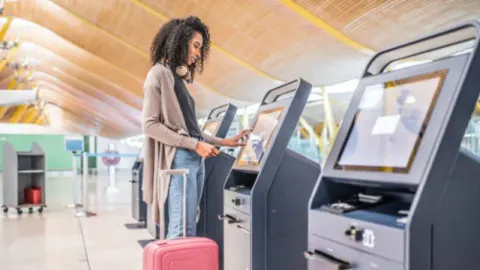
Both the cinema and airline industries are turning to self-service kiosks to improve flow and stay competitive. Operators want fewer staffing bottlenecks and more predictable costs. Kiosk tech solves both.
Here’s what’s driving the adoption:
- 84% of cinema operators say they’ve either added kiosks or plan to in the next 12 months
- 9 out of 10 major airports in the U.S. now support kiosk-based check-in and bag tagging
- Kiosks reduce service time by up to 60%, and help venues operate with smaller staff teams
- The global self-service kiosk market is projected to hit $$43.65B by 2028 (BusinessWire Research Report)
These systems are now standard infrastructure in high-traffic environments.
Benefits of Self-Service Kiosks In the Entertainment & Cinema Industry
Businesses that adopt self-service kiosks enjoy several benefits. But the most noticeable ones fall into three key categories.
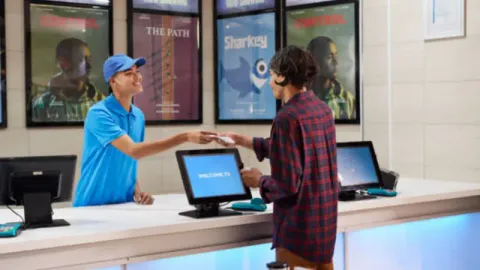
1. Self-Service Kiosks Reduce Labor Costs in the Travel and Entertainment Industry
- Reduce Front-Desk Load Without Sacrificing Service
A four-screen movie theater can route 70–80% of ticket sales through kiosks during peak hours. That means fewer employees are stuck behind the counter. More are available for ushering, food delivery, or handling escalations. Airports use kiosks for basic check-in so staff can focus on irregular operations and priority passengers.
- Reassign Staff to Experience-Focused Roles
Self-service handles repeatable tasks. That frees employees to focus on upselling and guest interaction. It also keeps the environment organized. A leaner front desk doesn’t mean lower service…it often means better service in the places that matter.
- Lower Payroll and Scheduling Pressure Across Sites
Labor shortages have hit both the cinema and airline industries hard. Kiosks reduce dependency on manual staffing and help operators stay open, even during understaffed shifts. Fewer check-in agents mean more reliable coverage.
2. Self-Service Improves Customer Experience Where It Counts
- Faster Service with Fewer Queues
Nobody enjoys waiting. Kiosks let customers check in or buy tickets in under two minutes…without holding up the line. That means faster lobby flow at theaters and shorter queues at the airport check-in zone.
- Multilingual Support Meets Global Demand
Kiosks support multiple languages, making them friendly to international travelers and non-English-speaking moviegoers. That eliminates confusion and improves customer confidence in unfamiliar settings.
- Personalization (Upsells, Promos, and Preferences)
Smart kiosks remember customer behavior. Frequent flyers or loyal theater guests see custom prompts. As these kiosks collect customer data, they offer upgrade options, promo codes, or quick reorders based on past visits. That turns a routine task into a faster, more familiar experience.
3. Self-Service Tech Directly Boosts Per-Customer Revenue
- Built-In Upsell Prompts Boost Spend
At checkout, kiosks nudge customers to upgrade seats, add popcorn combos, or select better baggage options. These upsell prompts are timed and targeted—offering more without pressure.
- Loyalty Integration Increases Return Visits
Customers can scan loyalty cards or enter codes to redeem offers. These systems work without manual input, making it easier to earn points, apply discounts, and track spending.
- Real-world results Show Up on the Bottom Line.
Several theater chains report 10–15% higher average transaction values after switching to kiosk-first ticketing.
Airlines also see more premium seat upgrades when offers are shown on kiosks instead of by staff.
How to Use a Cinema Ticketing Kiosk (A Step-by-Step Process)
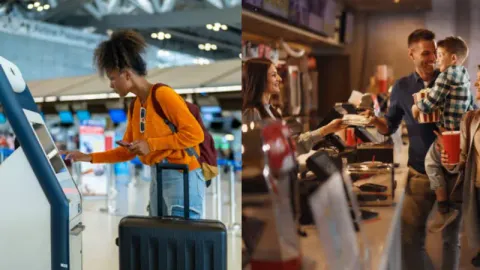
Cinema ticketing kiosks are easy to use. Most people can complete a purchase in under two minutes. But if it’s your first time, the process can feel unfamiliar.
Here’s a practical, step-by-step breakdown so you know exactly what to expect at the machine.
From Movie Selection to Checkout
There are 8 steps involved in completing a purchase at a movie kiosk.
- Start the session
Tap the screen to begin. Select your preferred language if prompted. - Choose your movie
Browse the list of current titles. Tap the one you want. - Pick a showtime
Choose a time slot that works for you. Make sure you’re selecting the correct date. - Select your seats
Use the interactive seat map to choose your seats. The screen will show available, taken, and premium seating options. - Choose ticket quantity
Select how many tickets you need. Some kiosks let you choose ticket types like adult, child, or senior. - Review your order
Double-check the showtime, seat numbers, and total cost. - Make your payment
Choose how to pay. Most kiosks accept cards, mobile payments, and sometimes cash. - Collect your ticket
You’ll receive either a printed ticket or a digital QR code, depending on what you selected.
Tips for a Smooth Experience
- Scan your loyalty card first
This applies to any available discounts or points before checkout begins. - Look closely at the seat map
Avoid selecting obstructed or front-row seats by mistake. - Use contactless payment
It’s quicker than cash or swiping a card and reduces touchpoints. - Save the digital version
If your ticket comes with a QR code, take a screenshot. It’s easier than searching your inbox later.
Planning to Add Kiosks in Your Theater or Venue? Here’s What to Know
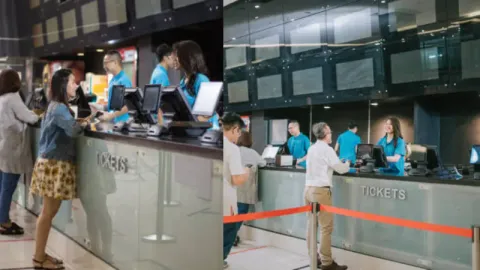
Adding self-service kiosks is an operational shift that needs precise planning and execution. From where you place the units to how your staff supports them…every detail affects usage and ROI.
Here’s what you need to get right.
Planning and Placement Strategy
Start with foot traffic data
Map your busiest entry points, lobby zones, and waiting areas. Know when and where lines tend to form.
Place kiosks where people pause
Install kiosks near entrances, next to concessions, or along common walkways. Avoid corners or behind pillars. Visibility drives usage.
Ensure full accessibility
Kiosks should meet ADA requirements. That includes adjustable height, clear sightlines, and tactile or audio support. Make sure screens are readable in all lighting conditions.
Selecting the Right Vendor or Solution
Look for hardware built for heavy use
The kiosk must stand up to constant tapping, scanning, and printing. Ask about screen durability, part replacement cycles, and uptime guarantees.
Check POS and CRM compatibility
Your kiosk must sync with your existing ticketing and loyalty systems. Avoid anything that needs custom middleware or manual syncing.
Ask about custom UI and promo support
Some vendors lock you into a generic layout. Choose one that lets you show promotions, brand visuals, or loyalty nudges on screen.
Pilot Testing and Staff Training
Start with one or two units
Run a pilot for at least 4–6 weeks. Monitor usage by time, transaction speed, and customer drop-off points.
Train staff to guide, not just watch
During the pilot, assign a team member to support kiosk users and report common issues. This reduces frustration and builds trust in the system.
Create a feedback loop
Track where users struggle (seat selection, payments, scanning) and adjust UI or signage accordingly. Let real usage shape your rollout.
Cost Breakdown and ROI of Ticketing Kiosks

Kiosks are a capital investment, but the long-term return can be substantial…if planned well. Here’s a breakdown of what to expect upfront and what to measure post-installation.
Read the full article on Self-service Kiosk cost here.
Typical Investment Range
Most cinema and ticketing kiosks cost between $3,000 and $7,500 per unit.
The price depends on features like barcode scanning, cash acceptance, and custom branding.
- Hardware: $2,500–$5,000 per unit
- Software licensing: $500–$1,500 annually per kiosk
- Installation and setup: $500–$1,000 one-time
- Ongoing maintenance: $300–$600/year per unit for service, updates, and support
Optional modules like concessions integration or loyalty programs may add to the total.
Operational ROI
Once deployed, kiosks reduce the need for front-desk staff while improving service speed.
- Fewer manual transactions = fewer input errors
- Faster checkouts = higher throughput before showtime
- Lower labor dependency = easier shift scheduling
One mid-size theater chain reduced lobby queues by 20% and saw a 10% lift in pre-show concession sales…just by moving 60% of traffic to kiosks (A report by eFinancialmodels).
Measurable Metrics to Watch
To track ROI clearly, monitor:
- Average transaction time per kiosk vs. staffed terminal
- Kiosk usage rate vs. box office usage
- Ticket-to-concession ratio before and after rollout
- Downtime or error rates that impact flow
Consistent tracking helps adjust placement, signage, and staff support to maximize returns.
Cinema vs. Airport Kiosks: What’s the Difference?
Cinema and airport kiosks may share the same hardware shell, but they serve very different goals. Here’s how they compare on function, system integration, and user experience:
| Aspect | Cinema Kiosk | Airport Kiosk |
|---|---|---|
| Primary Role | Enhance guest experience: tickets, seats, snacks, promos | Handle logistics: check-in, boarding pass, baggage tag |
| System Integration | Connects with POS, concessions, and loyalty CRM | Syncs with airline databases and ID verification tools |
| UI/UX Focus | Visual-rich, promotional, built for browsing | Fast, minimal taps, multilingual, built for speed |
The Future of Kiosk Technology in Entertainment and Travel
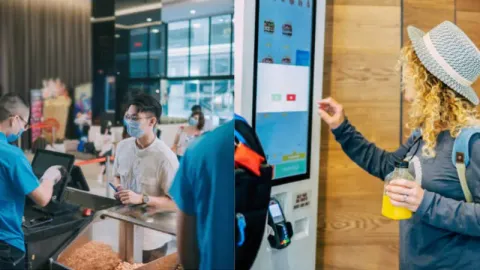
Kiosk systems are getting smarter and more connected. Here’s what’s coming next;
Emerging Innovations
- Voice-Activated Interfaces
Some kiosk systems now support basic voice navigation. This improves accessibility. It also speeds up standard selections without requiring any screen touches.
- Biometric Check-In
Airports are already testing face and fingerprint recognition to replace manual ID checks. Biometric-enabled kiosks confirm identity in seconds. They can also print boarding passes and match passengers to bookings. In theaters, facial recognition could eventually speed up loyalty check-ins or ticket retrieval.
- AI-Driven Suggestions
AI-powered kiosks suggest upgrades, better seats, or add-ons based on past purchases.
Offers are tailored by time of day, movie type, or loyalty tier—instead of being the same for everyone.
Unified Mobile + Kiosk Ecosystems
Cross-Platform Syncing
Expect more syncing between mobile apps and kiosk systems. A user might buy a ticket on their phone, then walk up to a kiosk to print it or order snacks—no manual input needed.
Live Promotions Based on Behavior
Kiosks will respond to real-time user behavior. If a guest hesitates during checkout, the system might offer a quick discount or free upgrade to close the sale.
Consistent UI Across All Devices
Mobile and kiosk interfaces are starting to mirror each other. This cuts down on user error and makes interactions more predictable across all platforms.
Best Practices to Maximize Your Kiosk’s Value
To get consistent results, operators need to focus on usability, reliability, and staff support.
These best practices help drive adoption and reduce friction.
UX and Accessibility
Use large, high-contrast buttons with simple step-by-step flows. Add multilingual support based on your customer base.
For ADA compliance, include audio prompts, reachable screens, and tactile navigation.
Maintenance and Updates
Schedule monthly software updates to fix bugs and improve speed. Run hardware checks weekly to spot screen issues, printer jams, or payment failures.
Kiosk uptime during peak hours is critical, especially before movie showtimes or early morning flights.
Staff Role Redefinition
Don’t remove staff…redeploy them. Assign someone to guide new users, clear jams, and monitor kiosk zones.
Theaters and airports that succeed with kiosks treat staff as kiosk ambassadors…ready to help when needed but not slowing down the flow.
Final Take: Cinema & Airport Kiosks Are A Necessity
Kiosks have moved from being a nice-to-have to a must-have. In cinemas, they boost combo sales and ease staff workload. In airports, they help move passengers efficiently—without needing extra agents. If your business wants to scale without growing headcount, smart kiosks are the answer.
CTA
Ready to upgrade your operations with future-ready kiosks?Explore solutions on our homepage or contact us to get expert advice tailored to your venue.



